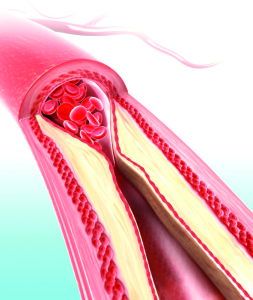Cholesterol
Cholesterol is highly connected to heart disease. Here we discuss the many facets of cholesterol and what you can do to control it.
What is Cholesterol?
Cholesterol is a substance your body makes naturally. It is soft and waxy, similar to fat, and is present in your body’s cells and in your bloodstream. Cholesterol is necessary to your survival—it’s what your body uses to make new cells. Much of the cholesterol in your body occurs naturally, but you also get a lot from the food you eat.
The truth is that cholesterol in itself is a good thing. The problem comes when your body has too much of the wrong kind of cholesterol. This creates an increased risk of cardiovascular disease, such as coronary heart disease and stroke—the No. 1 and No. 4 killers in the nation. In fact, people who have high levels of cholesterol are at twice the risk of developing heart disease as those with lower levels. Although high cholesterol is a clear health concern, it can be treated effectively.
How It Works
Cholesterol travels through the bloodstream to reach the cells. When there’s too much cholesterol in the bloodstream, it can bind with other substances in the blood to form a buildup on the interior walls of the arteries that carry blood to the heart. As plaque continues building up inside artery walls, it slowly starts to clog them (the process of atherosclerosis referenced throughout the HeartGuide).
Types of Cholesterol
There are three main types of cholesterol:
- Low-density lipoprotein (LDL) – Sometimes referred to as “lousy” or “bad” cholesterol, LDL helps substances stick to the inner walls of your arteries. Keeping LDL at lower levels is a healthy heart goal.
- High-density lipoprotein (HDL) – HDL is the “happy” or “good” type of cholesterol. It helps your arteries keep cholesterol from sticking to the artery walls and moving through the bloodstream. HDL cholesterol even helps remove cholesterol from your bloodstream. Higher levels of HDL are associated with good heart health.
- Triglycerides – These can also clog our arteries. Triglycerides are made by the body, but too many can be a bad thing for your health. Being overweight or obese or physically inactive, smoking, drinking too much alcohol, and eating too many simple carbohydrates can all increase triglyceride levels in your bloodstream. Diabetes and a family history of high triglyceride levels can also contribute to higher levels in your body.
Understand The Risks
- Diet – Eating foods low in saturated fat, triglycerides, and cholesterol can help you control your blood cholesterol and LDL.
- Weight and obesity – Carrying too much weight can also increase your risk. Being overweight or obese can raise LDL, total cholesterol, and triglyceride levels.
- Smoking – Tobacco smoke is terrible for your health. Among many other problems, it can raise your triglyceride levels and lower your levels of HDL.
- Physical activity – Your body needs physical activity for your overall health. People who don’t get enough physical activity can become overweight or obese. Getting the physical activity you need can actually help you lose weight and raise your level of HDL.
- Genes – Yes, you can inherit high levels of LDL and triglycerides, or low levels of HDL cholesterol, from your parents or other family members.
- Age – The older you get, the more likely you are to have abnormal cholesterol levels. Past the age of 65, the risk increases significantly.
Other health conditions can also put you at risk of high cholesterol, including liver disease, diabetes, underactive thyroid, kidney disease, and pancreatic disease. If you have two or more of any of the risk factors, you’re more apt to develop high cholesterol.
How to Check My Blood Cholesterol Level
The most common method for determining your cholesterol number is the fasting lipoprotein profile. The “fasting” part of the profile means that prior to the blood test, you had no food or drink for a period of time beforehand—usually eight hours.
This simple blood test measures total cholesterol, LDL cholesterol, HDL cholesterol, and triglyceride levels to get an overall picture of the presence of cholesterol in your bloodstream. The blood test itself takes only a few minutes and your health care team will usually go over the results with you in a future office visit or over the phone.
Understand the Cholesterol Numbers
Health care teams use one or more sets of clinical guidelines to determine your cholesterol situation and relative risk of cardiovascular disease. Talk with your health care team about your numbers and what they mean, as well as any other medical conditions and risk factors you may have. And ask what your goal should be.
Treatment for High Cholesterol
If your critical numbers are not within healthy ranges, you may very well be at a higher risk for cardiovascular disease. Your health care team will work with you to help you make improvements to your overall health and keep your risks for serious conditions at bay. Although medicine can be necessary to lower your cholesterol, it’s always important to maintain a healthy lifestyle, which includes eating right and getting regular exercise. Talk with your doctor before starting any diet or exercise program.
What Is FH?
Familial hypercholesterolemia (FH) is a genetic disorder in which LDL cholesterol is present in very high levels from birth. The severity of FH depends on a person’s genetic profile. If a person with FH inherited one faulty gene from a parent, that person’s LDL cholesterol level can be two to three times higher than normal. But if a person inherits two faulty genes (one from each parent), it can be worse—LDL levels three to six times higher than normal. Talk to your doctor to see if you should be tested for FH. Learn more at www.thefhfoundation.org.

